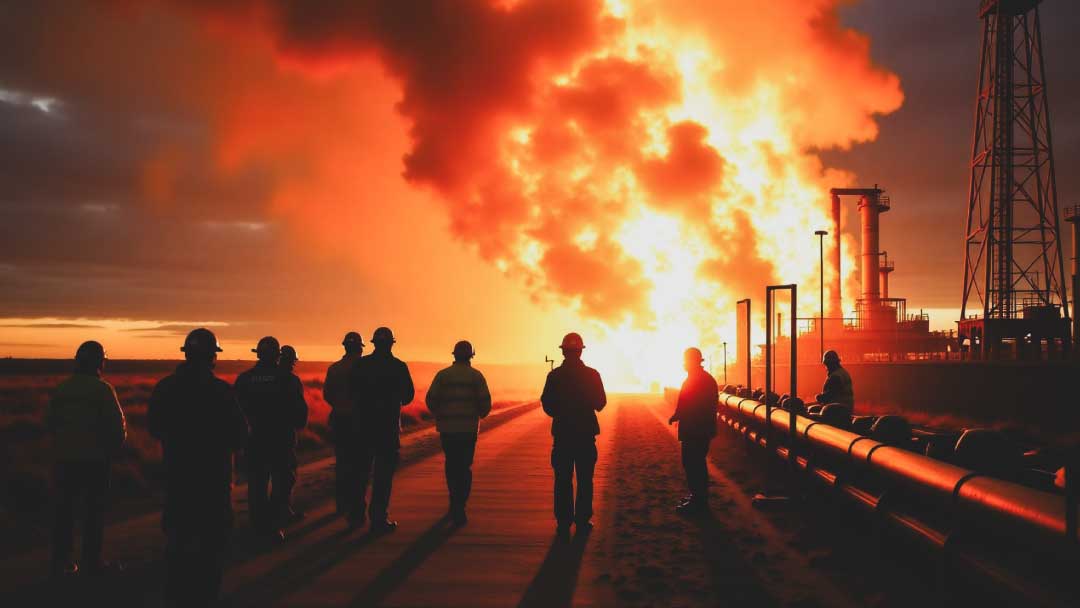Get Pricing Now!
Choose an option that works best for you.
Call Now for a free quote!
(844) 889-2536
Get a custom quote
Book your free consultation
Schedule a Call
Book my consultation
In the oil and gas industry, even a single incident can have far-reaching consequences.
An oil spill, pipeline rupture, or refinery explosion doesn’t just threaten workers and infrastructure… it can cause lasting environmental damage, trigger regulatory fines, and disrupt entire supply chains.
The cost of inaction or an inadequate response is simply too high.
That’s why proactive emergency response planning is critical.
When disaster strikes, companies must be ready to act immediately to contain the situation, protect people and assets, and minimize long-term damage. A well-prepared organization doesn’t just react to emergencies – it anticipates them and builds strategies to mitigate risk before disaster occurs.
At GPI Defense, we specialize in security solutions that support emergency response efforts, from securing disaster zones to coordinating with first responders and preventing unauthorized access.
In this article, we’ll break down key response protocols for oil spills and other industrial disasters, outlining the best ways to prepare, respond, and recover while keeping safety and compliance at the forefront.

A crisis doesn’t wait for a convenient time to strike. In the oil and gas industry, companies must assume that disasters will happen and take proactive steps to minimize their impact.
The most effective emergency responses don’t start when an incident occurs… they are carefully planned, drilled, and refined long before disaster strikes.
A well-structured Incident Response Plan (IRP) serves as the backbone of an organization’s emergency preparedness. This plan should include:
Simply having a plan isn’t enough – it must be tested and updated regularly. Conducting realistic emergency drills ensures that all personnel understand their roles and can act swiftly under pressure.
Training exercises should simulate worst-case scenarios, such as oil spills, gas leaks, or chemical fires, to test the effectiveness of response measures.
Preventing a disaster is always preferable to responding to one. Regular risk assessments help identify vulnerabilities that could lead to major incidents. Key areas of focus should include:
Compliance with safety regulations such as OSHA’s hazardous materials guidelines and the EPA’s spill prevention rules isn’t just about avoiding fines… it’s about ensuring that sites remain safe, secure, and prepared for potential emergencies.
By investing in strong pre-incident planning, oil and gas companies can reduce risks, improve response times, and protect both their personnel and the environment.
When an industrial disaster occurs, every second counts.
The speed and efficiency of the initial response determine whether the situation is contained or escalates into a large-scale crisis. The first priority is always human safety, followed by environmental protection and asset preservation.
The first moments of an emergency are the most critical. Employees, contractors, and response teams must act quickly to:
In an oil spill scenario, rapid containment is key. Facilities should have pre-positioned spill kits that include booms, absorbents, and skimmers to prevent the spread of hazardous materials. In cases of chemical leaks or gas explosions, fire suppression and ventilation control become top priorities.
Disaster response doesn’t happen in isolation. Oil and gas companies must immediately notify and coordinate with:
Having pre-established communication channels with local authorities ensures a faster, more coordinated response.
Companies that delay reporting incidents often face heavier fines and increased reputational damage.
Security teams play a crucial role in maintaining order, protecting assets, and ensuring that response efforts can proceed without interference.
When an incident occurs, controlling access to the site is one of the first security priorities. Unchecked entry can lead to:
Security personnel establish clear perimeters around affected zones, ensuring that only authorized personnel—such as first responders, regulatory inspectors, and facility leadership—are allowed access.
Disaster zones are often vulnerable to:
By integrating professional security services into disaster response planning, oil and gas companies strengthen their ability to respond effectively while reducing the likelihood of secondary threats.
Once the crisis has been contained, companies must focus on recovery and long-term prevention.
Long-term investments in safety and security not only protect lives and the environment but also reduce financial losses, legal liabilities, and reputational damage.
Proactive emergency planning, rigorous training, and a strong security presence are essential for minimizing damage and ensuring business continuity.
At GPI Defense, we specialize in providing security solutions that enhance emergency response efforts, ensuring that disaster zones remain secure and response teams can operate without interference.
Now is the time to review and update your emergency response plan… before disaster strikes.
Are you prepared?
“At GPI Defense, we protect more than just property… we actually safeguard your business from financial risks, theft, and legal liabilities.”